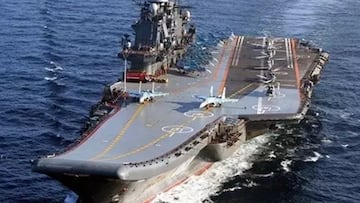Inside the Admiral Kuznetsov: Russia’s sole aircraft carrier returns to service after years in limbo
Built during the Soviet era, the Admiral Kuznetsov has undergone extensive repairs and is poised to rejoin Russia’s naval fleet.

The Admiral Kuznetsov, Russia’s only aircraft carrier, is set to rejoin its naval fleet after years of inactivity. Originally named Riga, the vessel was conceived during the Soviet Union and has been out of commission since 2017, when it was deployed to Syria to support the Assad regime against Islamist forces. During that mission, two aircraft—an Su-33 and a MiG-29—were lost.
A symbol of Russia’s naval power
The Admiral Kuznetsov stands as a symbol of Russia’s maritime ambitions, especially as the nation continues to showcase its military might during the ongoing war in Ukraine. While Russia has deployed many of its advanced weapons during the conflict, the Kuznetsov has remained docked, undergoing extensive repairs.
The ship’s last operational mission ended in 2017, and in 2019, it suffered a significant setback when a fire broke out during maintenance at the Murmansk port. The damage delayed its return to service, but now, after years of retrofitting, the carrier is reportedly ready to operate again. Originally commissioned in 1991, just before the dissolution of the Soviet Union, the Kuznetsov remains a crucial component of Russia’s naval force.
Extensive repairs and modern upgrades
The carrier owes its name to Nikolai Kuznetsov, a Soviet Navy officer during World War II. Recent renovations have introduced several modern features, including upgraded propulsion systems, new wiring, enhanced flight control systems, and a completely revamped deck. These updates aim to extend the vessel’s operational life and improve its combat readiness.
Cold War relic: Russia’s “Dead Hand” system
In addition to showcasing the Kuznetsov, Russia has also revived discussions about its “Dead Hand” system, an automated nuclear defense mechanism developed during the Cold War. This system was designed to ensure retaliation in the event of a nuclear strike that incapacitates the Russian chain of command, including its president and military leaders.
Initially created as a countermeasure against potential U.S. first-strike capabilities, “Dead Hand” highlights the lengths Russia has gone to maintain its strategic deterrence, even decades after the Cold War’s end.
The role of the Kuznetsov in modern warfare
With the Admiral Kuznetsov’s return to service, questions remain about its role in modern naval warfare. As a relic of Soviet engineering, it contrasts sharply with the advanced carriers of nations like the United States. However, its presence signals Russia’s intention to maintain its blue-water naval capabilities, even as the ship’s reliability has been questioned following years of setbacks.
Russia’s military ambitions remain under intense scrutiny, and the Kuznetsov’s reactivation is likely to attract attention from geopolitical observers and military analysts alike.
Related stories
This article was originally written in Spanish, translated with the assistance of AI and edited by David Nelson.
Get your game on! Whether you’re into NFL touchdowns, NBA buzzer-beaters, world-class soccer goals, or MLB home runs, our app has it all. Dive into live coverage, expert insights, breaking news, exclusive videos, and more – plus, stay updated on the latest in current affairs and entertainment. Download now for all-access coverage, right at your fingertips – anytime, anywhere.